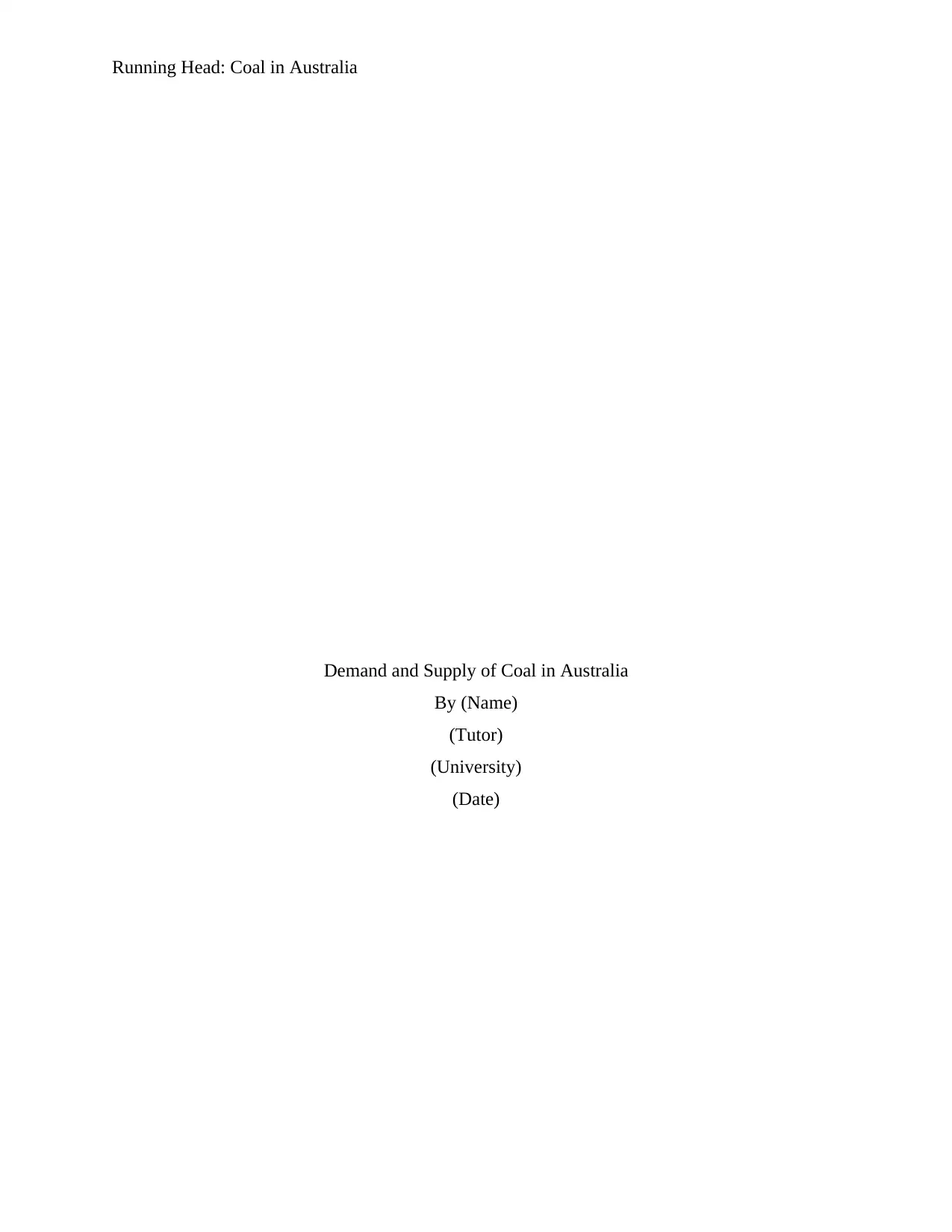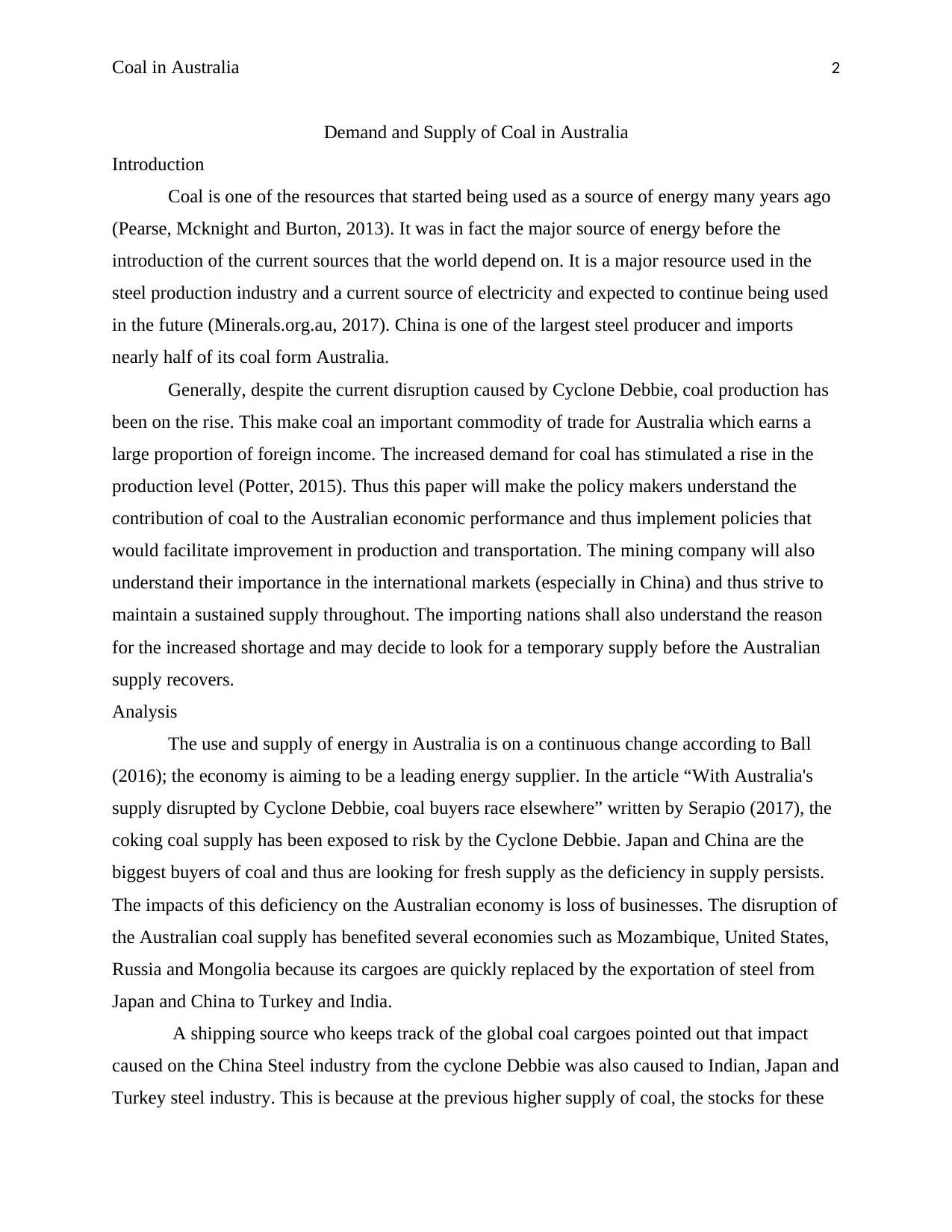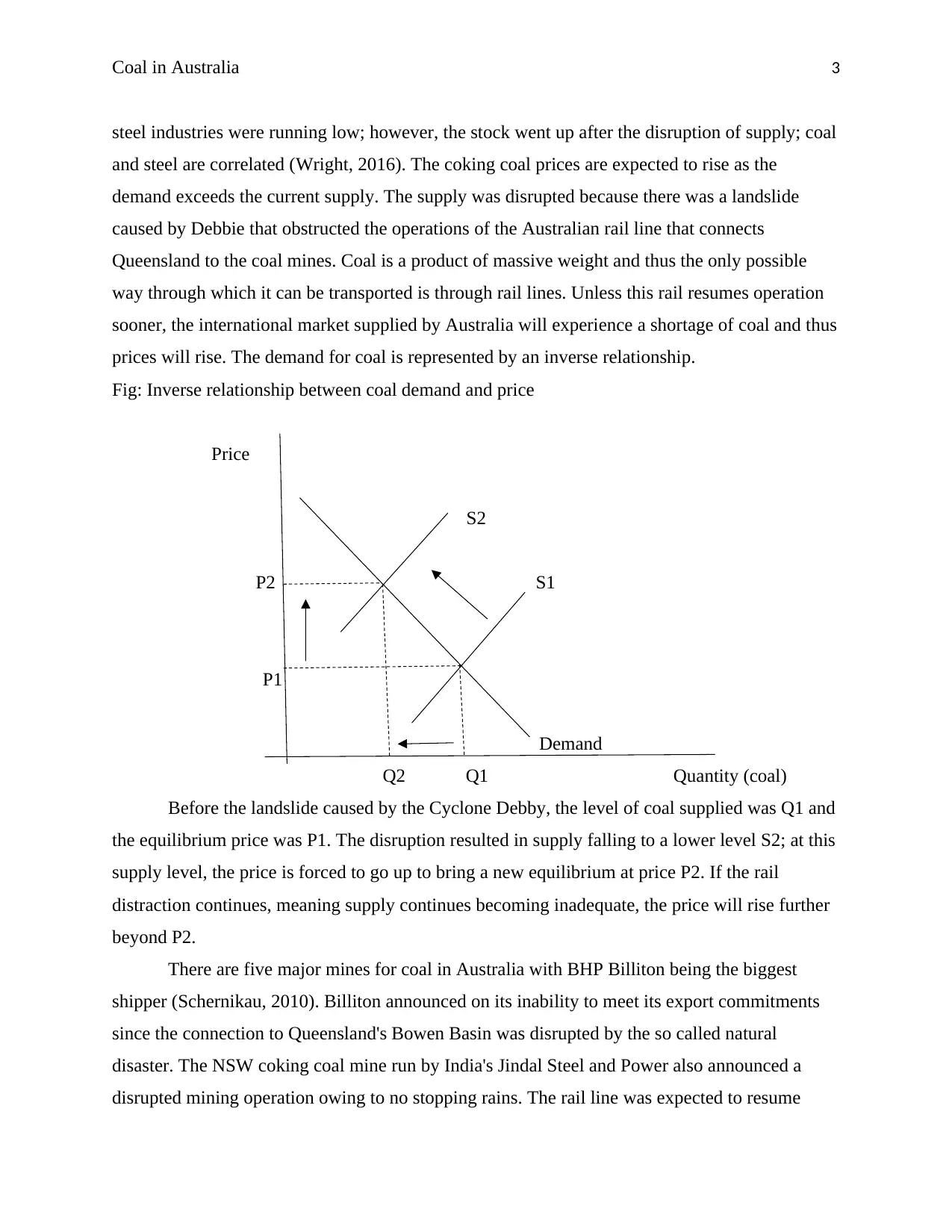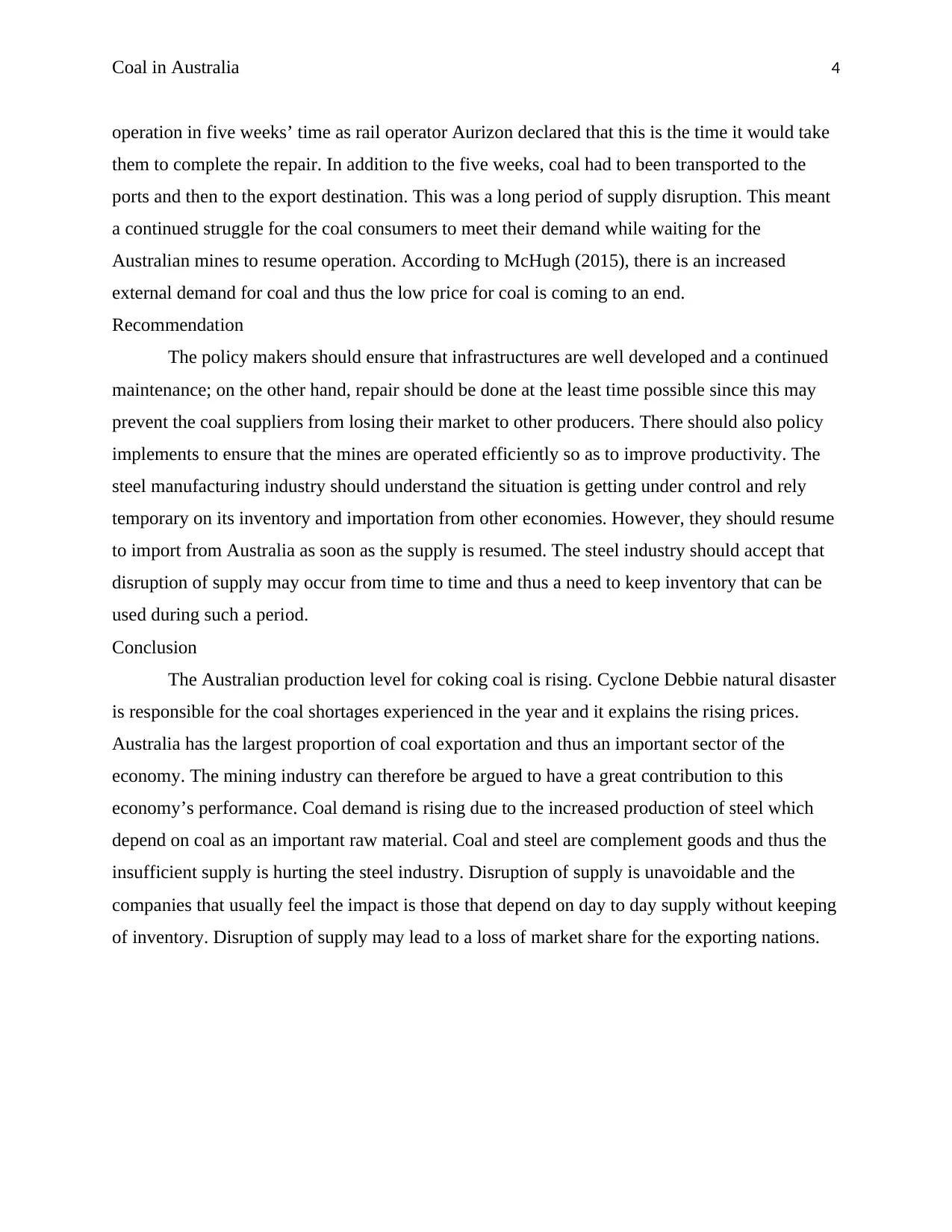Demand and Supply of Coal in Australia: An Economic Analysis Report
VerifiedAdded on 2020/02/24
|5
|1469
|45
Report
AI Summary
This report delves into the demand and supply dynamics of coal in Australia, highlighting its significance as a major commodity of trade and its contribution to the Australian economy. The analysis examines the impact of events such as Cyclone Debbie on coal production and supply chains, particularly focusing on the disruption to rail lines and its subsequent effect on international markets. The report explores the inverse relationship between coal demand and price, illustrating how supply disruptions lead to price increases. It also identifies key players in the Australian coal industry, such as BHP Billiton, and discusses the implications of supply shortages for steel manufacturing and other industries. The report recommends policy measures to ensure infrastructure maintenance and efficient mine operations, as well as strategies for steel manufacturers to manage supply disruptions. Ultimately, the report emphasizes the importance of the coal industry to the Australian economy and the need for proactive measures to mitigate supply chain vulnerabilities and ensure market stability.

Running Head: Coal in Australia
Demand and Supply of Coal in Australia
By (Name)
(Tutor)
(University)
(Date)
Demand and Supply of Coal in Australia
By (Name)
(Tutor)
(University)
(Date)
Paraphrase This Document
Need a fresh take? Get an instant paraphrase of this document with our AI Paraphraser

Coal in Australia 2
Demand and Supply of Coal in Australia
Introduction
Coal is one of the resources that started being used as a source of energy many years ago
(Pearse, Mcknight and Burton, 2013). It was in fact the major source of energy before the
introduction of the current sources that the world depend on. It is a major resource used in the
steel production industry and a current source of electricity and expected to continue being used
in the future (Minerals.org.au, 2017). China is one of the largest steel producer and imports
nearly half of its coal form Australia.
Generally, despite the current disruption caused by Cyclone Debbie, coal production has
been on the rise. This make coal an important commodity of trade for Australia which earns a
large proportion of foreign income. The increased demand for coal has stimulated a rise in the
production level (Potter, 2015). Thus this paper will make the policy makers understand the
contribution of coal to the Australian economic performance and thus implement policies that
would facilitate improvement in production and transportation. The mining company will also
understand their importance in the international markets (especially in China) and thus strive to
maintain a sustained supply throughout. The importing nations shall also understand the reason
for the increased shortage and may decide to look for a temporary supply before the Australian
supply recovers.
Analysis
The use and supply of energy in Australia is on a continuous change according to Ball
(2016); the economy is aiming to be a leading energy supplier. In the article “With Australia's
supply disrupted by Cyclone Debbie, coal buyers race elsewhere” written by Serapio (2017), the
coking coal supply has been exposed to risk by the Cyclone Debbie. Japan and China are the
biggest buyers of coal and thus are looking for fresh supply as the deficiency in supply persists.
The impacts of this deficiency on the Australian economy is loss of businesses. The disruption of
the Australian coal supply has benefited several economies such as Mozambique, United States,
Russia and Mongolia because its cargoes are quickly replaced by the exportation of steel from
Japan and China to Turkey and India.
A shipping source who keeps track of the global coal cargoes pointed out that impact
caused on the China Steel industry from the cyclone Debbie was also caused to Indian, Japan and
Turkey steel industry. This is because at the previous higher supply of coal, the stocks for these
Demand and Supply of Coal in Australia
Introduction
Coal is one of the resources that started being used as a source of energy many years ago
(Pearse, Mcknight and Burton, 2013). It was in fact the major source of energy before the
introduction of the current sources that the world depend on. It is a major resource used in the
steel production industry and a current source of electricity and expected to continue being used
in the future (Minerals.org.au, 2017). China is one of the largest steel producer and imports
nearly half of its coal form Australia.
Generally, despite the current disruption caused by Cyclone Debbie, coal production has
been on the rise. This make coal an important commodity of trade for Australia which earns a
large proportion of foreign income. The increased demand for coal has stimulated a rise in the
production level (Potter, 2015). Thus this paper will make the policy makers understand the
contribution of coal to the Australian economic performance and thus implement policies that
would facilitate improvement in production and transportation. The mining company will also
understand their importance in the international markets (especially in China) and thus strive to
maintain a sustained supply throughout. The importing nations shall also understand the reason
for the increased shortage and may decide to look for a temporary supply before the Australian
supply recovers.
Analysis
The use and supply of energy in Australia is on a continuous change according to Ball
(2016); the economy is aiming to be a leading energy supplier. In the article “With Australia's
supply disrupted by Cyclone Debbie, coal buyers race elsewhere” written by Serapio (2017), the
coking coal supply has been exposed to risk by the Cyclone Debbie. Japan and China are the
biggest buyers of coal and thus are looking for fresh supply as the deficiency in supply persists.
The impacts of this deficiency on the Australian economy is loss of businesses. The disruption of
the Australian coal supply has benefited several economies such as Mozambique, United States,
Russia and Mongolia because its cargoes are quickly replaced by the exportation of steel from
Japan and China to Turkey and India.
A shipping source who keeps track of the global coal cargoes pointed out that impact
caused on the China Steel industry from the cyclone Debbie was also caused to Indian, Japan and
Turkey steel industry. This is because at the previous higher supply of coal, the stocks for these

Coal in Australia 3
steel industries were running low; however, the stock went up after the disruption of supply; coal
and steel are correlated (Wright, 2016). The coking coal prices are expected to rise as the
demand exceeds the current supply. The supply was disrupted because there was a landslide
caused by Debbie that obstructed the operations of the Australian rail line that connects
Queensland to the coal mines. Coal is a product of massive weight and thus the only possible
way through which it can be transported is through rail lines. Unless this rail resumes operation
sooner, the international market supplied by Australia will experience a shortage of coal and thus
prices will rise. The demand for coal is represented by an inverse relationship.
Fig: Inverse relationship between coal demand and price
Price
S2
P2 S1
P1
Demand
Q2 Q1 Quantity (coal)
Before the landslide caused by the Cyclone Debby, the level of coal supplied was Q1 and
the equilibrium price was P1. The disruption resulted in supply falling to a lower level S2; at this
supply level, the price is forced to go up to bring a new equilibrium at price P2. If the rail
distraction continues, meaning supply continues becoming inadequate, the price will rise further
beyond P2.
There are five major mines for coal in Australia with BHP Billiton being the biggest
shipper (Schernikau, 2010). Billiton announced on its inability to meet its export commitments
since the connection to Queensland's Bowen Basin was disrupted by the so called natural
disaster. The NSW coking coal mine run by India's Jindal Steel and Power also announced a
disrupted mining operation owing to no stopping rains. The rail line was expected to resume
steel industries were running low; however, the stock went up after the disruption of supply; coal
and steel are correlated (Wright, 2016). The coking coal prices are expected to rise as the
demand exceeds the current supply. The supply was disrupted because there was a landslide
caused by Debbie that obstructed the operations of the Australian rail line that connects
Queensland to the coal mines. Coal is a product of massive weight and thus the only possible
way through which it can be transported is through rail lines. Unless this rail resumes operation
sooner, the international market supplied by Australia will experience a shortage of coal and thus
prices will rise. The demand for coal is represented by an inverse relationship.
Fig: Inverse relationship between coal demand and price
Price
S2
P2 S1
P1
Demand
Q2 Q1 Quantity (coal)
Before the landslide caused by the Cyclone Debby, the level of coal supplied was Q1 and
the equilibrium price was P1. The disruption resulted in supply falling to a lower level S2; at this
supply level, the price is forced to go up to bring a new equilibrium at price P2. If the rail
distraction continues, meaning supply continues becoming inadequate, the price will rise further
beyond P2.
There are five major mines for coal in Australia with BHP Billiton being the biggest
shipper (Schernikau, 2010). Billiton announced on its inability to meet its export commitments
since the connection to Queensland's Bowen Basin was disrupted by the so called natural
disaster. The NSW coking coal mine run by India's Jindal Steel and Power also announced a
disrupted mining operation owing to no stopping rains. The rail line was expected to resume
⊘ This is a preview!⊘
Do you want full access?
Subscribe today to unlock all pages.

Trusted by 1+ million students worldwide

Coal in Australia 4
operation in five weeks’ time as rail operator Aurizon declared that this is the time it would take
them to complete the repair. In addition to the five weeks, coal had to been transported to the
ports and then to the export destination. This was a long period of supply disruption. This meant
a continued struggle for the coal consumers to meet their demand while waiting for the
Australian mines to resume operation. According to McHugh (2015), there is an increased
external demand for coal and thus the low price for coal is coming to an end.
Recommendation
The policy makers should ensure that infrastructures are well developed and a continued
maintenance; on the other hand, repair should be done at the least time possible since this may
prevent the coal suppliers from losing their market to other producers. There should also policy
implements to ensure that the mines are operated efficiently so as to improve productivity. The
steel manufacturing industry should understand the situation is getting under control and rely
temporary on its inventory and importation from other economies. However, they should resume
to import from Australia as soon as the supply is resumed. The steel industry should accept that
disruption of supply may occur from time to time and thus a need to keep inventory that can be
used during such a period.
Conclusion
The Australian production level for coking coal is rising. Cyclone Debbie natural disaster
is responsible for the coal shortages experienced in the year and it explains the rising prices.
Australia has the largest proportion of coal exportation and thus an important sector of the
economy. The mining industry can therefore be argued to have a great contribution to this
economy’s performance. Coal demand is rising due to the increased production of steel which
depend on coal as an important raw material. Coal and steel are complement goods and thus the
insufficient supply is hurting the steel industry. Disruption of supply is unavoidable and the
companies that usually feel the impact is those that depend on day to day supply without keeping
of inventory. Disruption of supply may lead to a loss of market share for the exporting nations.
operation in five weeks’ time as rail operator Aurizon declared that this is the time it would take
them to complete the repair. In addition to the five weeks, coal had to been transported to the
ports and then to the export destination. This was a long period of supply disruption. This meant
a continued struggle for the coal consumers to meet their demand while waiting for the
Australian mines to resume operation. According to McHugh (2015), there is an increased
external demand for coal and thus the low price for coal is coming to an end.
Recommendation
The policy makers should ensure that infrastructures are well developed and a continued
maintenance; on the other hand, repair should be done at the least time possible since this may
prevent the coal suppliers from losing their market to other producers. There should also policy
implements to ensure that the mines are operated efficiently so as to improve productivity. The
steel manufacturing industry should understand the situation is getting under control and rely
temporary on its inventory and importation from other economies. However, they should resume
to import from Australia as soon as the supply is resumed. The steel industry should accept that
disruption of supply may occur from time to time and thus a need to keep inventory that can be
used during such a period.
Conclusion
The Australian production level for coking coal is rising. Cyclone Debbie natural disaster
is responsible for the coal shortages experienced in the year and it explains the rising prices.
Australia has the largest proportion of coal exportation and thus an important sector of the
economy. The mining industry can therefore be argued to have a great contribution to this
economy’s performance. Coal demand is rising due to the increased production of steel which
depend on coal as an important raw material. Coal and steel are complement goods and thus the
insufficient supply is hurting the steel industry. Disruption of supply is unavoidable and the
companies that usually feel the impact is those that depend on day to day supply without keeping
of inventory. Disruption of supply may lead to a loss of market share for the exporting nations.
Paraphrase This Document
Need a fresh take? Get an instant paraphrase of this document with our AI Paraphraser

Coal in Australia 5
References
Ball, A. (2016). Australia Energy Update 2016. [Online] Industry.gov.au. Available at:
https://www.industry.gov.au/Office-of-the-Chief-Economist/Publications/Documents/aes/2016-
australian-energy-statistics.pdf [Accessed 23 Aug. 2017].
McHugh, B. (2015). Divergent views on the impact on Australia's struggling coal sector as India
announces plans to double consumption. [Online] ABC Rural. Available at:
http://www.abc.net.au/news/rural/2015-12-10/debate-over-future-of-australian-coal-industry-
and-indian-demand/7010772 [Accessed 23 Aug. 2017].
Minerals.org.au. (2017). Characteristics of the Australian Coal Industry. [Online] Available at:
http://www.minerals.org.au/resources/coal/characteristics_of_the_australian_coal_industry
[Accessed 23 Aug. 2017].
Pearse, G., Mcknight, D. and Burton, B. (2013). Big coal: Australia's dirtiest habit. Sydney,
N.S.W.: NewSouth Publishing.
Potter, B. (2015). Australia's coal exports set to rise as south-east Asia demand surges. [Online]
Financial Review. Available at: http://www.afr.com/business/mining/coal/australias-coal-
exports-set-to-rise-as-southeast-asia-demand-surges-20151013-gk7sms [Accessed 23 Aug.
2017].
Schernikau, L. (2010). Economics of the international coal trade: the renaissance of steam coal.
Dordrecht, Springer.
Serapio, M. (2017). With Australia's supply disrupted by Cyclone Debbie, coal buyers race
elsewhere. [Online] The Sydney Morning Herald. Available at:
http://www.smh.com.au/business/mining-and-resources/with-australias-supply-disrupted-by-
cyclone-debbie-coal-buyers-race-elsewhere-20170406-gvfo1f.html [Accessed 23 Aug. 2017].
Wright, P. (2016). Raw Material Prices: Iron Ore, Scrap, Coking Coal & Zinc. [Online]
Steelmarketupdate.com. Available at: https://www.steelmarketupdate.com/blog/9418-raw-
material-prices-iron-ore-scrap-coking-coal-zinc [Accessed 23 Aug. 2017].
References
Ball, A. (2016). Australia Energy Update 2016. [Online] Industry.gov.au. Available at:
https://www.industry.gov.au/Office-of-the-Chief-Economist/Publications/Documents/aes/2016-
australian-energy-statistics.pdf [Accessed 23 Aug. 2017].
McHugh, B. (2015). Divergent views on the impact on Australia's struggling coal sector as India
announces plans to double consumption. [Online] ABC Rural. Available at:
http://www.abc.net.au/news/rural/2015-12-10/debate-over-future-of-australian-coal-industry-
and-indian-demand/7010772 [Accessed 23 Aug. 2017].
Minerals.org.au. (2017). Characteristics of the Australian Coal Industry. [Online] Available at:
http://www.minerals.org.au/resources/coal/characteristics_of_the_australian_coal_industry
[Accessed 23 Aug. 2017].
Pearse, G., Mcknight, D. and Burton, B. (2013). Big coal: Australia's dirtiest habit. Sydney,
N.S.W.: NewSouth Publishing.
Potter, B. (2015). Australia's coal exports set to rise as south-east Asia demand surges. [Online]
Financial Review. Available at: http://www.afr.com/business/mining/coal/australias-coal-
exports-set-to-rise-as-southeast-asia-demand-surges-20151013-gk7sms [Accessed 23 Aug.
2017].
Schernikau, L. (2010). Economics of the international coal trade: the renaissance of steam coal.
Dordrecht, Springer.
Serapio, M. (2017). With Australia's supply disrupted by Cyclone Debbie, coal buyers race
elsewhere. [Online] The Sydney Morning Herald. Available at:
http://www.smh.com.au/business/mining-and-resources/with-australias-supply-disrupted-by-
cyclone-debbie-coal-buyers-race-elsewhere-20170406-gvfo1f.html [Accessed 23 Aug. 2017].
Wright, P. (2016). Raw Material Prices: Iron Ore, Scrap, Coking Coal & Zinc. [Online]
Steelmarketupdate.com. Available at: https://www.steelmarketupdate.com/blog/9418-raw-
material-prices-iron-ore-scrap-coking-coal-zinc [Accessed 23 Aug. 2017].
1 out of 5
Related Documents
Your All-in-One AI-Powered Toolkit for Academic Success.
+13062052269
info@desklib.com
Available 24*7 on WhatsApp / Email
![[object Object]](/_next/static/media/star-bottom.7253800d.svg)
Unlock your academic potential
Copyright © 2020–2025 A2Z Services. All Rights Reserved. Developed and managed by ZUCOL.




